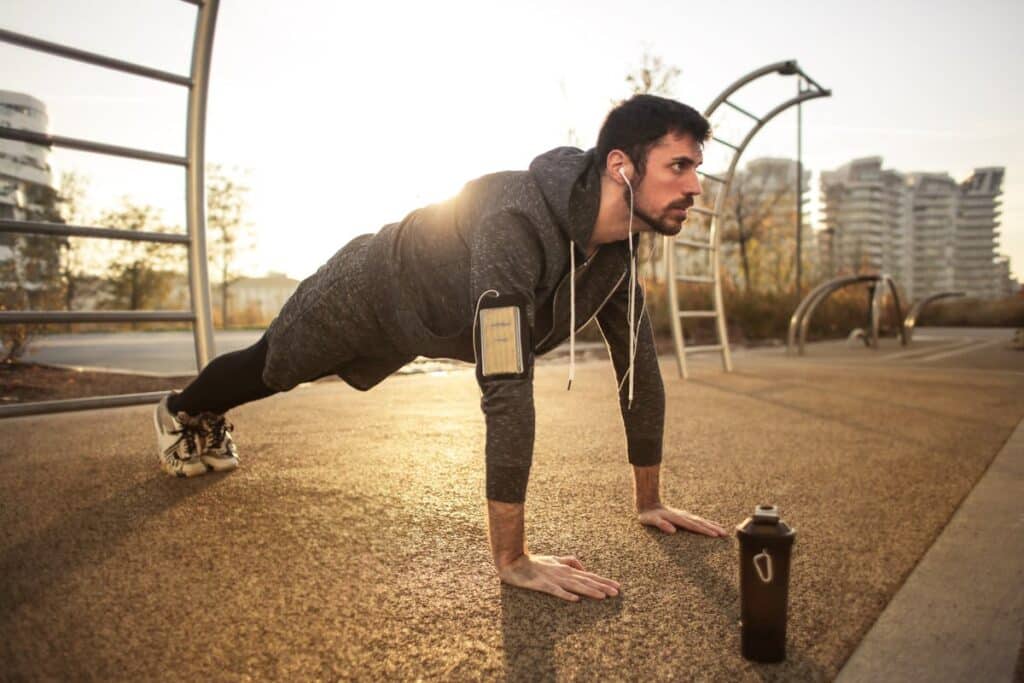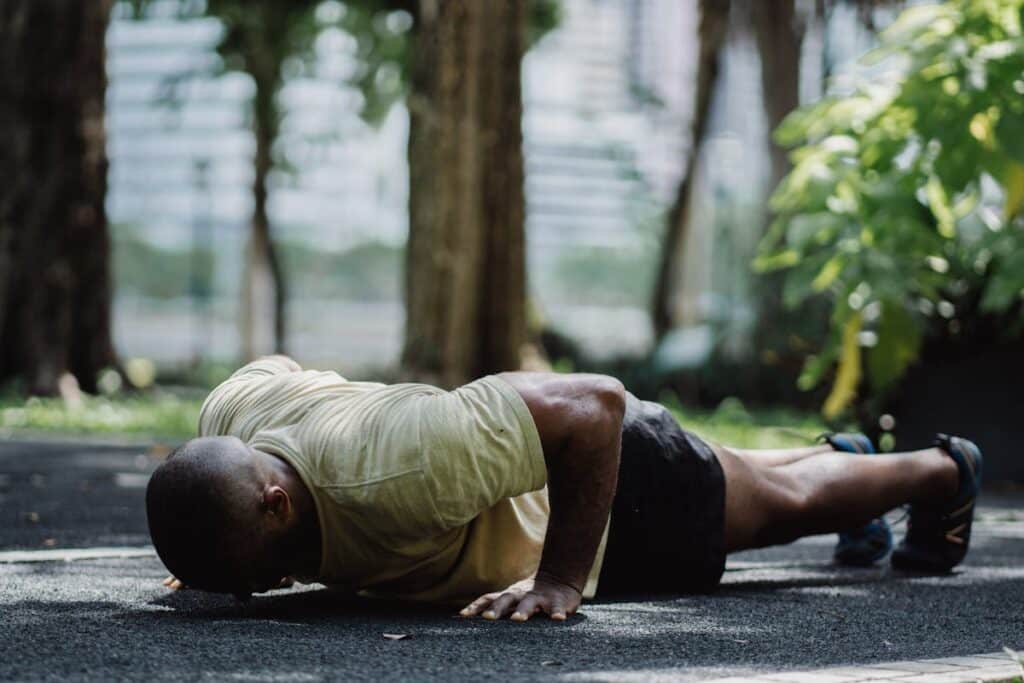
Burning question – Push Ups or Dips? Both are stellar total-body exercises that sky-rocket your heart rate, sculpt lean muscle, and can be executed virtually anywhere, with zero equipment. In today’s deep dive, we compare dips vs. push ups. We’ll unravel which packs a mightier punch by exploring the strengths, weaknesses, and best practices of each.
In this article
What are dips?
Dips – Are they worth the hype? Absolutely. Dips are a powerful compound exercise often hailed as the “upper body squat” due to their effectiveness in building strength and muscle mass in the upper body.
Performed using parallel bars or a dip station, this exercise involves hoisting yourself up by gripping the bars, then lowering your body by bending your elbows until your shoulders are below your elbows. You then push back up to the starting position.

How It Works
When performing dips:
- Your arms support and move your body weight.
- Your legs generally hang freely, and you can cross your feet for stability.
- You can lean forward to emphasize the chest muscles or remain more upright to focus the effort on the triceps.
Muscles Targeted
Dips primarily engage the lower fibers of the chest, all three heads of the triceps, and the front deltoids. The extent to which these muscles are targeted can be adjusted by changing your body’s inclination during the exercise.
Leaning forward emphasizes the chest muscles, especially the lower chest while maintaining a more upright posture focuses more intensely on the triceps.
Pros and cons of dips
Dips are a highly effective exercise for building upper body strength, but like any exercise, they have both advantages and disadvantages. Here’s a detailed look at the pros and cons of performing dips:
Pros:
- Dips are excellent for targeting multiple muscle groups simultaneously, including the triceps, chest, and shoulders, making them a very efficient exercise for upper body development.
- Regularly performing dips can significantly enhance upper body strength as they require lifting your entire body weight, which can rapidly build muscle power and endurance.
- Dips can be modified to target different muscle groups more intensely; leaning forward during the exercise emphasizes the chest muscles, while a more upright position focuses on the triceps.
- Dips help in developing functional strength that is beneficial for everyday activities and other sports, enhancing your overall fitness and athletic performance.
- Dips can be performed with just a set of parallel bars or even between two sturdy chairs at home, making them a convenient addition to any workout routine.
Cons:
- The intense load on the shoulders during dips can be risky, especially for individuals with pre-existing shoulder conditions. Improper form can also lead to strains or injuries.
- Dips are quite demanding and might not be suitable for beginners who lack the initial strength to lift their body weight.
- While weights can be added to increase difficulty, scaling dips down for beginners or those recovering from injury can be challenging without specific equipment like assisted dip machines.
- Performing dips excessively, especially without proper form, can lead to overuse injuries, emphasizing the need for careful integration into workout routines.
What are push-ups?

Push-ups are performed by positioning yourself face down with your hands placed slightly wider than shoulder-width apart. You raise and lower your body using your arms while keeping the body straight and rigid from head to heels.
Why should push-ups rank high in your exercise routine? A key reason lies in their versatility. Push-ups engage multiple muscle groups, from your arms and chest to your core and glutes. Furthermore, they can be easily modified to suit varying fitness levels. No other exercise lets you work the upper body and core equally effectively, in one smooth motion.
How It Works
The basic movement involves:
- Lowering your body to the ground by bending your elbows while maintaining a straight line from your head to your heels.
- Pushing your body back up until your arms are extended, but not locked, to complete one repetition.
Muscles Targeted
The primary muscles worked during push-ups include:
- Pectoral Muscles (Chest): Push-ups primarily engage the chest muscles, helping in their development and strengthening.
- Triceps: The triceps are actively involved in extending the elbow during the lifting phase of the push-up.
- Deltoids (Shoulders): The shoulder muscles stabilize and support the arms during the exercise.
Pros and cons of push-ups
Pros:
- One of the biggest advantages of push-ups is that they don’t require any equipment. You can perform them anywhere, making them perfect for home workouts or while traveling.
- Push-ups engage not only the upper body but also the core and lower body to some extent. This makes them an effective full-body exercise that improves overall muscular endurance and strength.
- They can be easily modified to increase or decrease intensity, catering to all fitness levels. Variations like inclined push-ups or diamond push-ups can help target specific muscle groups more intensely.
- Regular practice of push-ups helps improve posture and stability by strengthening the core muscles, which are crucial for maintaining proper posture.
Cons:
- Push-ups can be challenging for beginners, especially those who lack upper body strength. This can lead to frustration or discouragement if not approached gradually.
- Incorrect form during push-ups can lead to injuries, particularly in the shoulders and lower back. It’s crucial to maintain proper form to avoid strain.
- For those with pre-existing wrist or shoulder issues, traditional push-ups might exacerbate these conditions. Modifications or alternative exercises might be necessary to accommodate such limitations.
- While push-ups are great for overall fitness, they might not be sufficient for those looking to build significant muscle mass or achieve specific strength goals without incorporating additional resistance or weights.
Differences and Similarities between dips and push-ups
Both dips and push-ups are easy to do anywhere since you only need your body. They work multiple upper body muscles and are straightforward exercises. However, they differ in some key ways that might affect your workout choice.
Body Angle
The way you position your body during these exercises affects which part of your chest gets worked:
- Push-Ups: These work more of the upper chest.
- Dips: These focus on the lower chest because of the vertical pressing motion.
Range of Motion
How much you can move during these exercises also differs:
- Dips: Allow a greater range of motion since you can move your shoulders below your hands.
- Push-Ups: Are limited by the ground, which stops your shoulders from moving down as far.
Body Weight Percentage Lifted
This explains why dips are generally harder than push-ups:
- Dips: You lift your whole body weight.
- Push-Ups: You lift about 60% of your body weight, making them a bit easier.
Which One Is Best? Dips vs. Push-Ups
Choosing between dips and push-ups depends on what you want from your workout. Dips are great for targeting the lower chest and triceps, making them a good choice if you’re looking to build strength in these areas. They involve lifting your entire body weight, so they can be quite challenging, especially for beginners. You’ll also need access to equipment like parallel bars.
On the other hand, push-ups are more versatile and easier to get into. They mainly work the upper chest and are less intense since you’re only lifting about 60% of your body weight. This makes push-ups more suitable if you’re starting out or if you don’t have access to gym equipment since you can do them anywhere.
So, if you’re after intense muscle work and have the equipment, dips might be better. But if you want a more accessible exercise that still gives a good workout, push-ups are the way to go. Ultimately, the best choice depends on your fitness goals and what’s practical for you.
Can you do include both dips and push ups in your routine?
Dips versus push ups – do you need to choose? The answer is no. Combining both these exercises gives you a full spectrum upper body workout. While dips enhance specific muscle power and definition, push ups build total-body functionality. Together, they can turn you into a powerhouse of strength, stamina, and agility.
Dip Variations You Should Try
- Bench Dips: This variation is great for beginners and can be done with a bench or any stable surface. It targets the triceps and is less intense than using parallel bars.
- Ring Dips: Performed using gymnastic rings, this variation increases the difficulty due to the instability of the rings, enhancing muscle activation and coordination.
- Weighted Dips: If you’re looking to increase the challenge, adding a weight belt or holding a dumbbell between your feet can significantly boost the intensity.
- Straight Bar Dips: Done on a single straight bar, this variation shifts the focus slightly more towards the chest and shoulders and requires good balance and control.
- Korean Dips: Performed on a straight bar but with the body passing behind the bar, this advanced variation increases the range of motion and difficulty.
Push up variations You Should Try
- Diamond Push-Ups: By placing your hands close together to form a diamond shape, this variation focuses more on the triceps and the inner chest.
- Decline Push-Ups: Elevating your feet on a bench or step increases the intensity of the push-ups, targeting the upper chest and shoulders more.
- Archer Push-Ups: These involve stretching one arm out to the side while bending the other, significantly working the chest and increasing unilateral strength and balance.
- Explosive (Clap) Push-Ups: Adding an explosive element to push-ups, where you push off the ground to clap in mid-air, helps develop power and fast-twitch muscle fibers.
- Spiderman Push-Ups: As you lower into a push-up, you bring one knee to the elbow on the same side. This adds a core challenge as it engages the obliques in addition to the standard push-up muscles.
For more push up variations, click here.
Bottomline
In conclusion, navigating the dips versus push ups debate boils down to your personal fitness goals. If muscle isolation and definition is your holy grail, dips should take precedence. If all-round physical conditioning is your game, push ups emerge as the optimal choice. But the beauty lies in their combination, making for a complete upper-body workout that challenges and changes your body in all the ways that matter. So why not master both and reap the all-around benefits?
